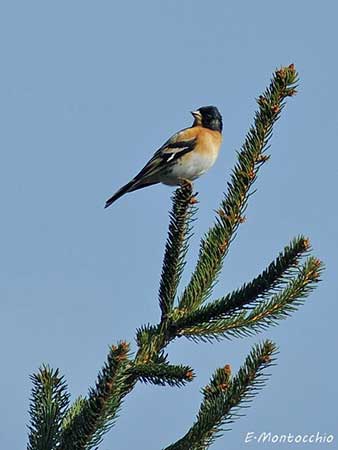
Fr: Pinson du Nord
Ang: Bramblig
All: Bergfink
Esp: Pinzón Real
Ita: Peppola
Nd: Keep
Sd: Bergfink
Photographers:
Eugène Montocchio
Galerie Photos Nature
Ingo Waschkies
Bird Photography
Text by Nicole Bouglouan
Sources :
HANDBOOK OF THE BIRDS OF THE WORLD Vol 15 by Josep del Hoyo-Andrew Elliot-David Christie - Lynx Edicions – ISBN: 9788496553682
ENCYCLOPEDIE DES OISEAUX DE FRANCE ET D’EUROPE – de Peter Hayman et Rob Hume - Flammarion – ISBN : 2082009920
THE COMPLETE BOOK OF BRITISH BIRDS – Written by “Royal Society for the Protection of Birds” experts - Préface de Magnus Magnusson - Michael Cady- Rob Hume Editors - ISBN: 0749509112
THE HANDBOOK OF BIRD IDENTIFICATION FOR EUROPE AND THE WESTERN PALEARCTIC by Mark Beaman, Steve Madge - C. Helm - ISBN: 0713639601
BirdLife International (BirdLife International)
What Bird-The ultimate Bird Guide (Mitchell Waite)
Birds of Britain - The Web Magazine for Birdwatchers
Brambling
Fringilla montifringilla
Passeriformes Order – Fringillidae Family
INTRODUCTION:
The Brambling is included in the subfamily Fringillinae in the family Fringillidae, alongside with the Common Chaffinch and the Blue Chaffinch.
This species is mainly a seed-eater and its migration is usually related to seed availability, involving some unpredictability of the stopover locations.
In the three species, only the males sing to establish the territory and attract a mate.

DESCRIPTION OF THE BIRD:
Biometrics:
Length: 14-16 cm
Weight: 17-30 g (in average 23 g)
The adult male in breeding plumage has glossy black head, mantle and upper back, whereas centre of lower back and rump are white. The uppertail-coverts are greyer with brown tips. Scapulars are pale orange like the lesser coverts. On the black upperwing, the median coverts are white and the greater coverts have broad white tips. The inner primaries have white base forming a small white patch on closed wings. Secondaries and tertials have pale buffish edges, broader on tertials. The tail is black.
On the underparts, the chin is pale orange, but breast, upper belly and flanks are darker. We can see some blackish spots on the rear flanks. Belly and vent are white with some pale orange on undertail-coverts. On the underwings, the coverts are bright yellow.
The conical bill is black, sometimes blue-grey with black tip. The eyes are dark brown. Legs and feet are dark brown to blackish.
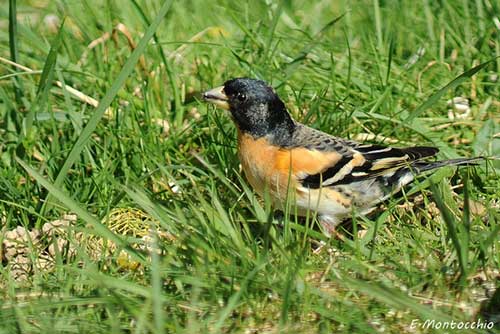
Adult male in spring
Almost in breeding plumage
The non-breeding male has mottled head and upperparts, with brownish edges and grey-brown tips to feathers. Nape and hindneck are pale grey, whereas the neck sides are bluish-grey. There is sometimes a pale brown eyering or a partial one. The scapulars are broadly tipped pale orange. The tinged orange median and greater coverts are tipped white. The flight feathers are dark brown with paler edges.
The adult female in breeding plumage resembles non-breeding male, but she has paler brown head and face. Sides of crown and nape are blackish, whereas the centre of the crown shows pale-tipped feathers. Nape and neck sides are paler grey. Cheeks and ear-coverts are grey-brown. The upperparts are globally paler and duller than on male.
The bill can be all blackish-grey.
The female in non-breeding plumage has paler head and upperparts, and duller underparts with more diffuse dark spots on rear flanks.
The bill is horn-coloured with paler base, and legs and feet are brown.
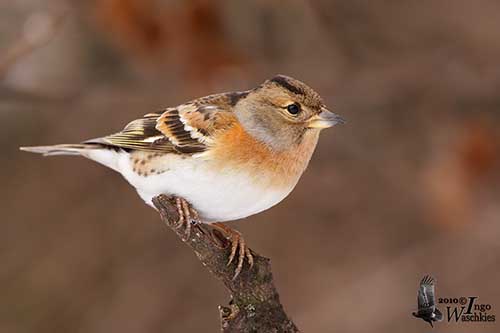
The juvenile resembles female but it is browner, with extensive pale brown tips to feathers on upperparts. Rump and belly are tinged dull yellow.
RANGE:
The Brambling breeds in N and NE Europe, E in a broad band to E Russia, S to NE Kazakhstan, C and SE Altai, Tuva, S Lake Baikal and Russian Far East.
It migrates to W, C and S Europe, N Africa, Middle East, and SW, C and E Asia.
HABITAT:
The Brambling occurs throughout the forests of N Europe and Asia. It breeds in birch and coniferous forests, and mixed conifer and deciduous woodlands.
During the non-breeding season, it frequents areas with deciduous trees, and can be seen along the edges of cultivated fields, grassy fields and in orchards. It can be seen at bird tables too is the snow covers the ground.
This species is visible up to 3000 metres of elevation in the Himalayas.
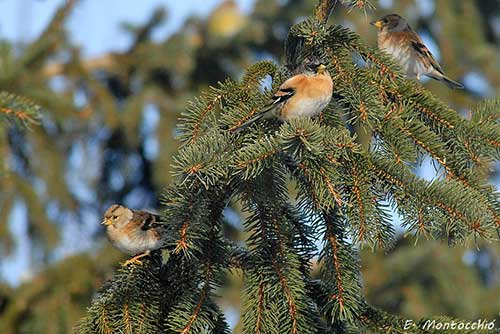
CALLS AND SONGS: SOUNDS BY XENO-CANTO
The Brambling’s call is a sharp, nasal “zweeee” frequently given by the male during the breeding season. We can also hear a musical “dweee” similar to that of the European Greenfinch and a sharp “chink” note, similar to the “tink” of the Common Chaffinch. The alarm call is a sharper “zweee” note. The flight call is a soft “chuc”.
The song is a series of sweet and melodious twitters, chirps, trills and fluty notes described as “zip chii tschrr” followed by larger wheezing “zweeee”. These notes are sometimes interspersed with quieter twitters and a descending rattle.
The song is usually given from prominent perch by the male, while the crown feathers are raised. Prior to their return to the breeding areas, several males often sing in chorus.
BEHAVIOUR IN THE WILD:
The Brambling feeds primarily on seeds and fruits, but it also takes small invertebrates and their larvae.
During winter, it often forages on the ground, digging into the leaf litter while searching for seeds. They form large flocks of thousands of birds, and they roost together at communal nightime roosts.
During summer, it forages mainly in low vegetation, but also in bushes and trees, taking invertebrates from foliage, branches and tree trunks. It may also pursue and catch insects in flight. It forages singly, in pairs or in small groups.
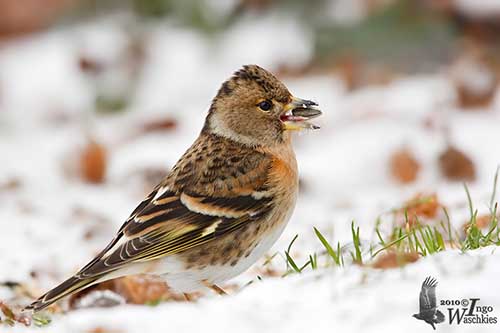
The Brambling is monogamous and the pair-bonds last only one season. It is solitary-nester, but sometimes, it nests close to colonies of Fieldfares. The male defends the nesting-site.
During the courtship displays, it utters a wheezing song from an exposed perch. The bill is wide open, the head back, the crown feathers are raised and the wings are drooped to enhance both white rump and wingbars. Some low flights are also performed with flicking wingbeats. The nest is built by the female but the male takes part in chick-rearing.
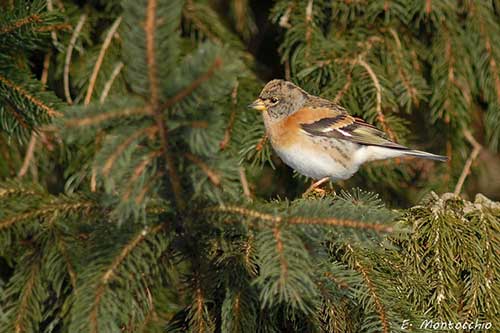
The Brambling is migratory and moves S after the breeding season, reaching W, C and S Europe, N Africa, Middle East and SW, C and E Asia.
The flight is somewhat bounding, with rapid wingbeats interspersed with short periods of wings pulled to the sides.
REPRODUCTION OF THIS SPECIES:
The breeding season takes place between May and early August. The female builds the nest, a large cup of grass, heather, bark strips, moss and lichens, plant down, fur and feathers, and spider webs. She adds sometimes pieces of string or paper. The nest is placed between 1 and 15 metres above the ground in a tree, or occasionally low in scrub or even on the ground.
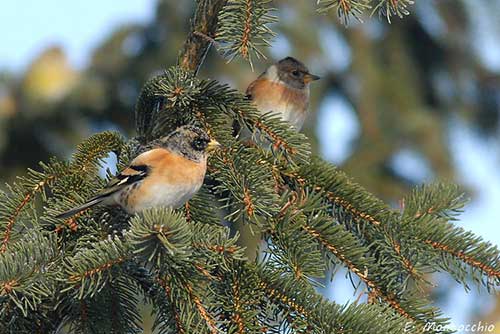
She lays 5-7 pale blue to olive-brown eggs with darker markings. She incubates alone during 11-12 days, but she is fed by the male during this period. The chicks are fed by both parents and fledge 13-14 days after hatching. They can breed in the first year.
The nest is parasitized by the Common Cuckoo in some areas. The main predators are Corvidae such as the Carrion Crow and the Spotted Nutcracker.
PROTECTION / THREATS / STATUS:
The Brambling is common or locally common throughout the range, with 13,000,000/20,000,000 breeding pairs in Europe which is 25/49% of the global range. The total population is placed in the band 79,600,000/264,000,000 individuals (2004). A moderate decline is suspected, but currently, the Brambling is evaluated as Least Concern.
